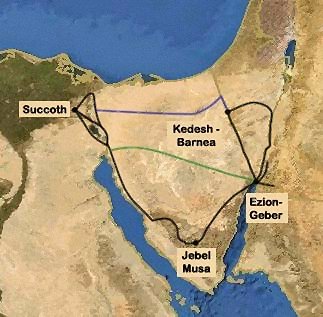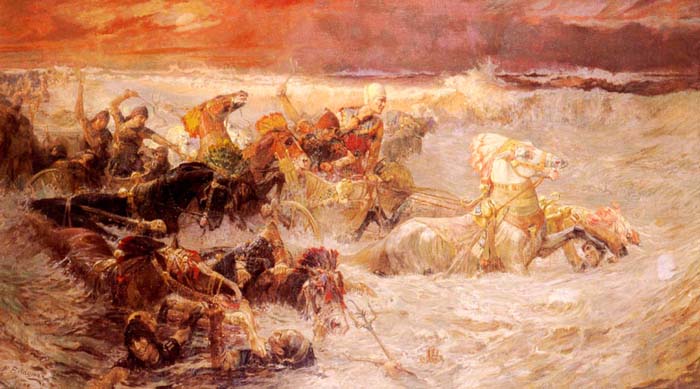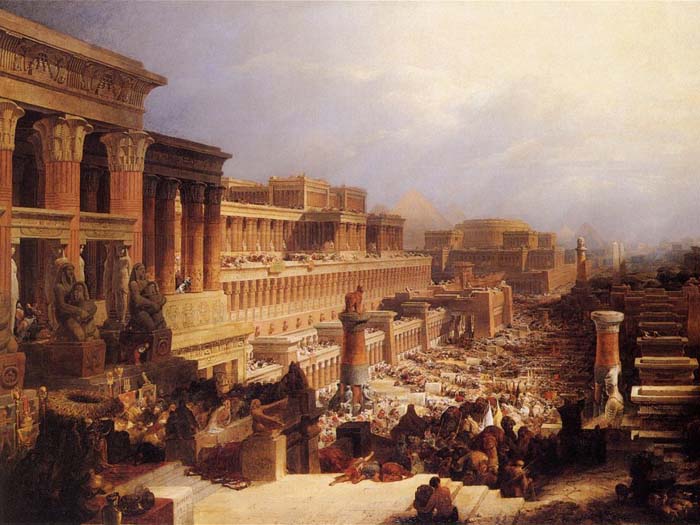The Exodus
The Exodus in ancient Egypt refers to a time when the Israelites were led out of Egypt by Moses. The Israelites had been in Egypt for hundreds of years, and eventually became so numerous that the Pharaoh decided he couldn’t trust them. He didn’t want to take the chance that they could oust him from his position, so he turned them all into slaves.
What was the Exodus?
The Israelites lived as slaves in Egypt for 400 years until the time God inflicted the ten plagues upon Egypt, in an effort to convince the Pharaoh to free the Israelite slaves. Some accounts place the number of Israelites in the Exodus at 500,000, while others place the number at 2.5 million. Whether or not the Exodus from ancient Egypt ever truly happened is questioned by scholars, but remains a popular theory today.
The Route of the Exodus

© ThaThinker - Map of possible Exodus Routes
Located on the Eastern Delta of the Nile, the land of Goshen is where the Israelites were enslaved by the Egyptians. It was from here that the Exodus started. After the ten plagues ravaged Egypt, the Pharaoh (the specific pharaoh remains a question), allowed the Israelites to leave Egypt. The Israelite men, women and children crossed into the Egyptian wilderness where they eventually approached the Red Sea.
Back in Egypt, the Pharaoh decided he didn’t want to let the Israelite slaves go because of the humiliation it caused his throne. He ordered his armies to slaughter them and with nowhere to run but the Red Sea, they called to Moses for help. When Moses raised his staff, The Red Sea parted and the Israelite slaves were able to cross through the sea on dry land. According to the legend, when the Pharaoh’s men went after the Israelites across the parted Red Sea, the waters closed back up and drowned them all.

Pharaoh's army engulfed by the Red Sea, oil on canvas, by Frederick Arthur Bridgman
Once the Israelites reached the other side of the Red Sea intact, they entered into the Sinai Wilderness. Here, they were tested by God for 40 years after which Moses led them to Mount Sinai. It was on Mount Sinai where Moses was given the Ten Commandments by God.
Date and Chronology of the Exodus
There is some speculation as to the exact date the Exodus took place. The date is believed to be around 1313 B.C. But before that time, leading up to the Exodus, the Jews lived as slaves in Egypt for over 400 years since 1850 B.C. or so. Moses, who saved the Israelites and led them out of Egypt at 80 years old, was born in 1393 B.C.
Moses
Moses was born in Egypt and was among those ordered to be killed, as he was a first-born Hebrew son. At three months old, he was set in a basket on the Nile River to escape the Pharaoh’s decree. He was saved by the Pharaoh’s daughter and raised in the palace. At 20 years old, Moses saw an Egyptian killing an Israelite and killed the Egyptian. The crime forced him to flee to the town of Midian where he married and had two sons. When he was 80 years old, God revealed himself to Moses in a burning bush. He instructed Moses to save the children of Israel. He died on Mount Nebo at the age of 120 years.

Moses parting the Red Sea
Archaeological Evidence
Even though the story of the Exodus out of ancient Egypt is the Torah’s basis for creation, there is no real archaeological evidence in support of it. The main issue is that with the sheer number of people migrating from one place to another, there should be some recording of it available. Some researchers believe that the actual number of people involved in the Exodus was far fewer than originally suspected. This would make the migration less of an impact on history.
Another issue is the parting of the Red Sea. Although it’s possible that a tsunami caused the waters to recede, it is still unlikely to have happened because the eventual giant wave would have drowned anyone in its way. Unfortunately, no real archaeological evidence exists for the Exodus.
The 10 Plagues of Egypt
Moses told the Pharaoh of Egypt that God wanted him to set the slaves Israelites free. If he didn’t comply, he was warned, God would strike Egypt with 10 plagues. According to the story of Exodus, Egypt was struck with every one of these plagues:
- The Nile River turned to blood
- The arrival of thousands of frogs
- A plague of lice
- Swarms of flies
- Diseased cattle and other livestock
- Boils on people’s skin
- Heavy hail that turned to fire when it landed
- A plague of locusts
- Darkness for three entire days
- Death of the first-born son, which included the house of the pharaoh
Click here to learn more about the 10 plagues

The Israelites Leaving Egypt, oil on canvas, by David Roberts
Other Theories about the Exodus
- Josephus, a first century historian, believed that the exodus was actually the migration of the Hyksos from ancient Egypt. This theory has merit because a stele by pharaoh Ahmose I depicts dramatic storms, which would correspond nicely to the plagues that supposedly ravaged Egypt during the time of the exodus of the Israelites.
- Some believe that the pharaoh Akhenaten was the actual Moses. This is because Akhenaten was the first Egyptian Pharaoh to believe in one god (monotheism) and Moses was also monotheistic, living around the same time period.
- The Exodus story may have been “copied” from the Egyptian myth of Osiris and Isis. To prove the Israelites’ faith and their existence as the chosen people, they may have adopted the myth of Osiris and Isis in their own words with their own people.
Facts about the Exodus in Ancient Egypt
- The identity of the pharaoh during the Exodus is still undetermined. There are cases for Ahmose I, Akhenaten, Ramses I, Tuthmosis III or Hatshepsut, or Seti II.
- Two cities mentioned in the Exodus, Pithom and Ramesses never existed at the same time.
- The Exodus is remembered every year during the feast of Passover.
- To avoid having their first-born son killed, people were told to place the blood of a lamb on their doorstep. When the angel of death saw this offering, he would “pass over” the house and spare the child, and go on to the next. This was the Passover.
- The Israelites first went to Egypt in search of food because of a famine in their country.
- It wasn’t until the implementation of the last plague (the killing of all first born males) that the pharaoh decided to let the Israelite slaves go free.
